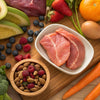How to Make Homemade Raw Dog Food: A Comprehensive Guide for Paw Parents
- Houndsy
Table of Contents
- Introduction
- The Benefits of Homemade Raw Dog Food
- Essential Ingredients for Homemade Raw Dog Food
- How to Create a Balanced Homemade Raw Dog Food Meal
- Easy Homemade Raw Dog Food Recipes
- Safeguarding Your Pup's Diet While Feeding Raw
- Conclusion
- FAQs
Introduction
Did you know that a significant number of dog owners are turning to homemade raw diets to provide better nutrition for their furry friends? In fact, a survey found that nearly 30% of pet owners are considering making their own pet food due to concerns about commercial products. If you’ve ever wondered how to take control of your dog’s diet, this blog post is for you.
As pet parents, we want what’s best for our dogs, and feeding them the right kind of food is a crucial aspect of responsible pet ownership. Commercially processed dog food might be convenient, but it often lacks the freshness and nutrient variety that homemade raw dog food can provide. Our goal here is to empower you with information about how to make homemade raw dog food that is both nourishing and delicious for your pup.
In this guide, we will explore the benefits of a raw dog food diet, the essential ingredients you need to include, how to create balanced meals, and some delicious recipes to get you started. By the end of this post, you’ll have a comprehensive understanding of how to craft high-quality, homemade raw meals for your canine companion. We invite you to reflect on your current feeding routines and consider the improvements that homemade raw dog food could bring to your dog’s health and happiness.
The Benefits of Homemade Raw Dog Food
When we decide to prepare homemade raw dog food, it’s not just about convenience or cost; it’s about the health and well-being of our pets. Here are some compelling reasons why homemade raw food may be a better option for our furry friends:
1. Control Over Ingredients
One of the most significant advantages of making your own raw dog food is the control it affords us over the quality and source of the ingredients. We can select fresh, organic meats, seasonal vegetables, and wholesome grains, ensuring that our dogs are eating a diet free from preservatives, fillers, and artificial flavors that are often found in commercial dog food.
2. Customization for Health Needs
Every dog is unique, and their dietary needs may vary based on age, breed, activity level, and specific health conditions. By preparing homemade meals, we can customize the ingredients to address allergies, sensitivities, or particular nutritional requirements.
3. Improved Digestion and Health
Many dog owners report that their pets experience better digestion, healthier skin and coats, and improved energy levels when switched to a raw diet. The inclusion of enzymes, probiotics, and fresh ingredients may contribute to these health benefits.
4. Avoidance of Recalls
Feeding a homemade raw diet significantly reduces the risk of feeding our pets tainted or recalled pet food. With commercial dog food recalls being relatively common, prepping meals ourselves offers peace of mind.
5. Strengthening the Bond with Our Dogs
Preparing meals from scratch can enhance the bond we share with our dogs. The act of cooking and feeding becomes a shared experience, fostering trust and strengthening our connection.
Now that we understand the benefits, let’s dive into what we need to know about making a balanced homemade raw dog food diet.
Essential Ingredients for Homemade Raw Dog Food
Creating a balanced homemade raw dog food meal involves the proper combination of different food groups. Here’s an overview of the essential components we should include in our recipes:
1. Protein Sources
Protein is the cornerstone of a raw dog food diet. Quality sources include:
- Muscle Meats: Chicken, beef, lamb, turkey, and fish provide essential amino acids.
- Organ Meats: Liver, kidneys, and heart are nutrient-dense options rich in vitamins and minerals.
2. Raw Meaty Bones (RMBs)
Including raw meaty bones is important for providing additional protein, calcium, and natural dental benefits. Bones should be appropriate for your dog’s size and chewing capability. Good options include chicken necks, wings, and other soft, non-weight-bearing bones.
3. Fruits and Vegetables
Fruits and vegetables serve as great sources of fiber, vitamins, and antioxidants. Some safe options to consider are:
- Carrots
- Spinach
- Kale
- Blueberries
- Sweet potatoes
4. Healthy Fats
Incorporating healthy fats helps to keep our dogs' coats shiny and skin healthy. Best options include fish oil, flaxseed oil, and coconut oil.
5. Supplements
Depending on your dog's health and nutritional needs, certain supplements may be beneficial. For instance, probiotics, omega-3 oils, and joint support supplements can be included as needed.
How to Create a Balanced Homemade Raw Dog Food Meal
1. Establish Ratios
When preparing homemade raw dog food, striving for balance is key. A common guideline is to follow the 80:10:10 rule:
- 80% muscle meat and bones
- 10% organs
- 10% fruits and vegetables
Alternatively, if you wish to include carbohydrates, you may consider a 60:20:20 ratio of protein, fruits and veggies, and carbohydrates.
2. Portion Control
Understanding portion sizes is essential to manage your dog’s weight. A general guideline for adult dogs is to feed 2-3% of their ideal body weight daily. For example, a 50-pound dog would typically require between 1 to 1.5 pounds of food per day based on their activity level.
3. Introduce New Foods Gradually
Transitioning your dog to a homemade raw diet should be done gradually. Begin by mixing small portions of homemade food with their current diet to allow their digestive system to adapt.
4. Monitor Health and Adjust
Regular vet check-ups are vital when changing your dog’s diet. Be sure to evaluate their health, coat condition, and energy levels, adjusting the recipe as necessary.
Easy Homemade Raw Dog Food Recipes
Now that we’ve covered the ingredients and foundational knowledge, let's move on to some practical recipes. Each of these is designed to provide balanced nutrition to your dog while being easy to prepare.
Recipe 1: Chicken & Vegetable Power Bowl
Ingredients:
- 2 lbs raw chicken (with bone)
- 1/2 cup chicken liver or gizzards
- 1 cup mixed vegetables (e.g., carrots, spinach, zucchini)
- 1 raw egg (including shell for added calcium)
- 1 tbsp fish oil
Instructions:
- Finely chop or blend the vegetables for easier digestion.
- Mix all ingredients in a large bowl, ensuring even distribution.
- Portion into meal-sized servings, either for immediate use or freeze for later.
Recipe 2: Beef & Blueberry Energy Mix
Ingredients:
- 2 lbs raw beef (ground or stew meat)
- 1/2 cup beef liver or kidney
- 1/2 cup blueberries
- 1/2 cup shredded carrots
- 1 tbsp coconut oil
Instructions:
- Chop the organ meats if necessary and mix all ingredients thoroughly.
- Divide into portions, serving fresh or storing in airtight containers in the fridge or freezer.
Recipe 3: Turkey & Pumpkin Digestive Blend
Ingredients:
- 2 lbs raw turkey (ground or whole pieces with bone)
- 1/2 cup turkey liver
- 1/2 cup pumpkin puree (unspiced)
- 1/2 cup leafy greens (e.g., kale)
- 1 tbsp bone broth for added flavor
Instructions:
- Finely chop or puree the greens for easier digestion.
- Combine all ingredients until well mixed.
- Serve immediately or store in suitable containers for future meals.
Safeguarding Your Pup's Diet While Feeding Raw
1. Handle with Care
Raw feeding requires stringent hygiene practices. Always wash your hands and surfaces thoroughly after preparing raw meals to minimize the risk of bacterial contamination.
2. Transition Gradually
If introducing raw food into your dog's diet, transition gradually. Begin by mixing small portions with their current food to prevent digestive upset.
3. Consult a Professional
Every dog is unique, and while making homemade raw food can be incredibly rewarding, it's advisable to consult your veterinarian or a pet nutritionist if unsure about specific dietary needs.
Conclusion
Switching to a homemade raw dog food diet can have significant benefits for our furry friends, from enhanced health and vitality to the satisfaction of knowing exactly what goes into their meals. As we've explored, crafting these meals involves understanding ingredients, ratios, and recipe varieties. A little effort in the kitchen can lead to a healthier and happier canine companion!
If you're considering revamping your dog's feeding experience, we invite you to also explore the Houndsy Kibble Dispenser. Our flagship product ensures convenient feeding while keeping the process aesthetically pleasing and practical. You can check it out more here.
FAQs
Q1: Is homemade raw dog food safe for all dogs?
Yes, generally, homemade raw dog food can be safe for most dogs. However, it’s essential to consult with your veterinarian, especially if your dog has specific health conditions or dietary restrictions.
Q2: How do I know if a homemade raw diet is right for my dog?
Every dog has different nutritional needs. Monitor your dog’s overall health, energy levels, and digestion after transitioning to a raw diet. Regular consultations with a veterinarian can provide tailored advice based on your dog’s needs.
Q3: Can I mix homemade raw food with dry kibble?
Yes, many pet owners choose to mix homemade raw food with kibble to add variety and nutrition. However, gradual introductions are encouraged to avoid digestive issues.
Q4: How should I store homemade dog food?
Homemade dog food can be stored in airtight containers in the fridge for up to four days or frozen for later use. Always ensure that food is thoroughly thawed before serving.
Q5: What are signs my dog isn’t adapting well to a raw diet?
Common symptoms may include vomiting, diarrhea, or lethargy. If you notice persistent digestive upset, please consult your veterinarian immediately.
By understanding how to make homemade raw dog food, we can elevate our dogs' feeding experiences, ensuring they thrive each day!












